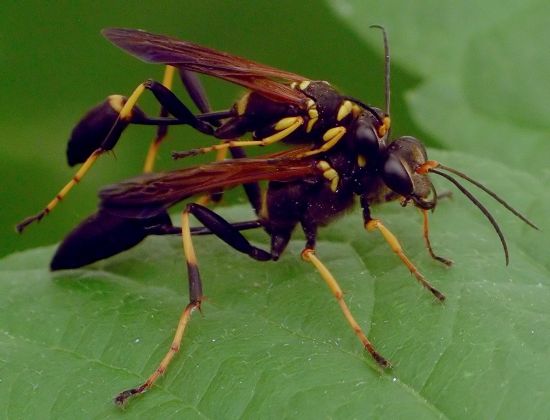by Valerie
January, 2010Black-and-yellow Mud Dauber
It's almost spring here in Texas, Valentine's Day is just around the corner, and love is in the air. With that introduction, what could be a better subject this month than a pair of amorous wasps? These are black-and-yellow mud daubers (Sceliphron caementarium) and the male is hanging onto the female in an attempt to coax her to mate with him. There are many species of wasps in our area, but this is one of the most common. The female collects mud in small balls and then uses it to build messy-looking chambers in sheltered areas. A solitary wasp, mud daubers often choose garages and storage sheds, eaves of buildings, and insides of motors on such tools as table saws and lawn mowers. Once a chamber is completed, the mother wasp stocks it with numerous paralyzed spiders, lays an egg, and seals it up. The egg that hatches produces a grub that feeds on the spiders. The larva then pupates and finally emerges as an adult. Although solitary, mud daubers will live quite close to their neighbors, and prime real estate might have a high population density of nests. The dried mud of the nest becomes quite hard and lasts long after the progeny of the original owner has emerged. At least one other wasp, the blue mud dauber, renovates abandoned nests for its own use. Other wasps are also attracted to the black-and-yellow mud daubers' nests. I've seen mason wasps probing and exploring around large conglomerations of mud dauber nest remains. They seem to be searching, perhaps for spiders or insects that have moved into the ruins, or maybe they cannot tell that the nests are old and are expecting to find fresh spiders. One wasp that can definitely determine that nests are fresh is the cuckoo wasp. This small gem-like metallic blue wasp looks for newly stocked mud dauber nests, gains entry when the resident wasp is not looking, and lays its own eggs inside. Just as the cuckoo lets other birds care for its young, so the cuckoo wasp lets other wasps do the rearing. |